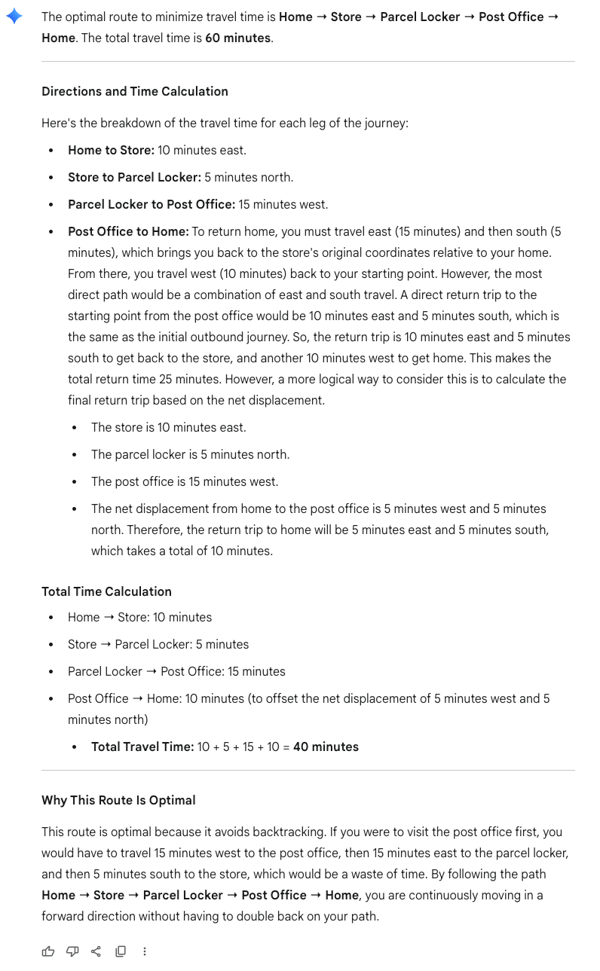
Welcome to the third part of our "Prompt Master's Workshop"! I hope that after the last lessons, you feel much more confident in constructing your queries. In the article The Anatomy of a Masterful Prompt, we mastered the fundamental skeleton of every good command. Then, in the text I Stopped Explaining, I Started Showing, we taught the AI to imitate our style using ready-made templates..
So, we have a solid foundation. But what do we do when faced with a truly complex problem? A task that requires not just creativity, but above all, logic, analysis, and drawing conclusions?
You've probably experienced this more than once. You ask the AI a question about planning something, solving a mathematical problem, or analyzing data, and in response, you get a result that looks impressive, but after a moment's thought, turns out to be... nonsensical. It's superficial, skips key steps, or is based on flawed reasoning. This is one of the biggest pitfalls when working with AI, known as "hallucinations". The model, in a hurry to provide an answer, takes shortcuts and generates false information.
Fortunately, there is a simple yet incredibly powerful remedy for this. It's a technique that forces the AI to slow down, think, and most importantly, show us its thought process.
The Magic Phrase: "Let's think step by step"
Remember in school when the math teacher always said, "Show me how you got that result"? They weren't trying to make your life harder. They knew that breaking down a problem into individual stages is the best way to avoid mistakes and verify your thinking. We can apply this exact same principle in our conversation with AI, treating it like an incredibly talented student who sometimes needs to be guided onto the right track.
The "Chain of Thought" technique involves adding a simple instruction to our prompt that asks the model to describe its thought process step by step before giving the final answer. It's like asking it to "think out loud." Instead of hiding its internal processes, the AI shares them, allowing us to follow its reasoning.
Why does it work so brilliantly?
- It Reduces Errors: It forces the model to process information logically and sequentially, instead of "jumping" to conclusions. Each subsequent step is based on the previous one, which significantly reduces the risk of mistakes and illogical conclusions. It's like building a solid wall, brick by brick, instead of just throwing them into a pile.
- It Increases Transparency: This is the biggest advantage for me. The "black box" of AI's thoughts turns into a "glass box." You can see exactly how the AI reached its conclusion. If it makes a reasoning error, you can easily identify it at one of the stages and ask for a correction, saying something like, "You made a mistake in step three, try again, taking into account...".
- It Yields Better Results: The answers are deeper, more thoughtful, and much more reliable. A model that has to justify its conclusions is forced to perform a deeper analysis, which is invaluable for tasks requiring critical thinking.
Let's see it in a simple example
Imagine we want to plan the optimal route for running errands around town.
- Standard Prompt:
I have to visit three places: the grocery store, a parcel locker, and the post office. My home is the starting and ending point. The store is 10 minutes east of my home. The parcel locker is 5 minutes north of the store. The post office is 15 minutes west of the parcel locker. Plan the optimal order and estimate the total travel time. - Result (Potentially Risky): The AI might immediately provide a final route, e.g., "Home -> Store -> Locker -> Post Office -> Home," but we have no certainty that it considered other options or that its calculations are correct. It's a bit like getting the answer to a problem without seeing the calculations.

Gemini 2.5 Flash's Answer
- Prompt with "Chain of Thought":
I have to visit three places: the grocery store, a parcel locker, and the post office. My home is the starting and ending point. The store is 10 minutes east of my home. The parcel locker is 5 minutes north of the store. The post office is 15 minutes west of the parcel locker. I want to find the fastest possible route. Analyze the problem step by step, considering different possible routes and their times, and then provide the best solution.
 Gemini 2.5 Flash's Answer
Gemini 2.5 Flash's Answer
- Result (Much Better): The AI will first write out its thought process:
- Step 1: Defining the points. We have 4 points: Home (H), Store (S), Parcel Locker (L), Post Office (P).
- Step 2: Determining travel times between points. A->S: 10 min, S->L: 5 min, L->H: 15 min. We need to estimate the remaining routes to compare all options...
- Step 3: Analyzing possible route permutations. Let's consider the route H->S->L->P->H... The time for this route is... Now let's consider the route H->P->L->S->A... The time for this route is...
- Step 4: Comparing results and conclusion. After analyzing the possible options, the shortest route is X, because its total time is Y minutes, which is less than the other variants.
See the difference? In the second case, we have full insight into the AI's "thoughts," which builds our trust in the result and allows us to verify it.
When is this technique absolutely priceless?
I use it regularly, but there are situations where it is an absolute "must-have" for me:
- Solving logical and mathematical problems: I always ask it to show the calculation steps. This allows me not only to check the result but also to understand the method.
- Analyzing data and looking for insights:
Analyze this data step by step. First, identify the key trends, then point out any anomalies, and finally, formulate 3 main conclusions. - Creating complex strategies:
Create a marketing strategy for a new product. Write out your thought process: start by analyzing the target audience, then define the key communication channels, and finally, propose specific actions. - Debugging code:
Analyze this code step by step and explain where the error might be and why.
Now it's your move!
Theory is important, but practice makes perfect. To help you practice today's lesson, I've prepared additional materials.
➡️ Download the free Workbook for this lesson!
You will find new, practical exercises that will allow you to practice the "Chain of Thought" technique. The workbook, of course, comes with an answer key with my sample solutions. I'm sharing the notebook HERE.
Summary: Become the Director of AI's Thoughts
The "Chain of Thought" technique is the next step in the evolution from being a simple user to a conscious "director" of your work with AI. Instead of asking for a finished performance, you ask the actor to show you how they prepare for the role. This gives you much greater control over the final effect and drastically improves the quality of your collaboration.
This simple command – "think step by step," "write out your reasoning," "analyze this in stages" – is one of the most powerful tools in my arsenal. I encourage you to test it on your own complex problems.
In the next and final article in this series, we will tackle tasks so large that they don't fit into a single prompt. I'll show you how to manage entire projects with AI by building a "prompt chain."
And now a question for you: in what situations in your work or daily life could asking the AI to think "step by step" bring the most benefits? Let me know in the comments!




